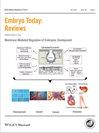Heleen Kool, Daphne Mous, Dick Tibboel, Annelies de Klein, Robbert J. Rottier
下载PDF
{"title":"Pulmonary vascular development goes awry in congenital lung abnormalities","authors":"Heleen Kool, Daphne Mous, Dick Tibboel, Annelies de Klein, Robbert J. Rottier","doi":"10.1002/bdrc.21085","DOIUrl":null,"url":null,"abstract":"<p>Pulmonary vascular diseases of the newborn comprise a wide range of pathological conditions with developmental abnormalities in the pulmonary vasculature. Clinically, pulmonary arterial hypertension (PH) is characterized by persistent increased resistance of the vasculature and abnormal vascular response. The classification of PH is primarily based on clinical parameters instead of morphology and distinguishes five groups of PH. Congenital lung anomalies, such as alveolar capillary dysplasia (ACD) and PH associated with congenital diaphragmatic hernia (CDH), but also bronchopulmonary dysplasia (BPD), are classified in group three. Clearly, tight and correct regulation of pulmonary vascular development is crucial for normal lung development. Human and animal model systems have increased our knowledge and make it possible to identify and characterize affected pathways and study pivotal genes. Understanding of the normal development of the pulmonary vasculature will give new insights in the origin of the spectrum of rare diseases, such as CDH, ACD, and BPD, which render a significant clinical problem in neonatal intensive care units around the world. In this review, we describe normal pulmonary vascular development, and focus on four diseases of the newborn in which abnormal pulmonary vascular development play a critical role in morbidity and mortality. In the future perspective, we indicate the lines of research that seem to be very promising for elucidating the molecular pathways involved in the origin of congenital pulmonary vascular disease. Birth Defects Research (Part C) 102:343–358, 2014. © 2014 Wiley Periodicals, Inc.</p>","PeriodicalId":55352,"journal":{"name":"Birth Defects Research Part C-Embryo Today-Reviews","volume":"102 4","pages":"343-358"},"PeriodicalIF":0.0000,"publicationDate":"2014-11-26","publicationTypes":"Journal Article","fieldsOfStudy":null,"isOpenAccess":false,"openAccessPdf":"https://sci-hub-pdf.com/10.1002/bdrc.21085","citationCount":"50","resultStr":null,"platform":"Semanticscholar","paperid":null,"PeriodicalName":"Birth Defects Research Part C-Embryo Today-Reviews","FirstCategoryId":"1085","ListUrlMain":"https://onlinelibrary.wiley.com/doi/10.1002/bdrc.21085","RegionNum":0,"RegionCategory":null,"ArticlePicture":[],"TitleCN":null,"AbstractTextCN":null,"PMCID":null,"EPubDate":"","PubModel":"","JCR":"Q","JCRName":"Medicine","Score":null,"Total":0}
引用次数: 50
引用
批量引用
Abstract
Pulmonary vascular diseases of the newborn comprise a wide range of pathological conditions with developmental abnormalities in the pulmonary vasculature. Clinically, pulmonary arterial hypertension (PH) is characterized by persistent increased resistance of the vasculature and abnormal vascular response. The classification of PH is primarily based on clinical parameters instead of morphology and distinguishes five groups of PH. Congenital lung anomalies, such as alveolar capillary dysplasia (ACD) and PH associated with congenital diaphragmatic hernia (CDH), but also bronchopulmonary dysplasia (BPD), are classified in group three. Clearly, tight and correct regulation of pulmonary vascular development is crucial for normal lung development. Human and animal model systems have increased our knowledge and make it possible to identify and characterize affected pathways and study pivotal genes. Understanding of the normal development of the pulmonary vasculature will give new insights in the origin of the spectrum of rare diseases, such as CDH, ACD, and BPD, which render a significant clinical problem in neonatal intensive care units around the world. In this review, we describe normal pulmonary vascular development, and focus on four diseases of the newborn in which abnormal pulmonary vascular development play a critical role in morbidity and mortality. In the future perspective, we indicate the lines of research that seem to be very promising for elucidating the molecular pathways involved in the origin of congenital pulmonary vascular disease. Birth Defects Research (Part C) 102:343–358, 2014. © 2014 Wiley Periodicals, Inc.
先天性肺异常导致肺血管发育异常
新生儿肺血管疾病包括广泛的病理条件与肺血管发育异常。肺动脉高压(pulmonary arterial hypertension, PH)的临床特征是血管阻力持续增强和血管反应异常。PH的分类主要基于临床参数而不是形态学,并将PH分为五组。先天性肺异常,如肺泡毛细血管发育不良(ACD)和PH相关的先天性膈疝(CDH),以及支气管肺发育不良(BPD),被分为第三组。显然,严密而正确地调控肺血管的发育对肺的正常发育至关重要。人类和动物模型系统增加了我们的知识,使识别和表征受影响的途径以及研究关键基因成为可能。了解肺血管的正常发育将为罕见疾病的起源提供新的见解,如CDH、ACD和BPD,这些疾病在全世界的新生儿重症监护病房中都是一个重要的临床问题。在这篇综述中,我们描述了正常的肺血管发育,并重点介绍了肺血管异常发育在新生儿发病率和死亡率中起关键作用的四种疾病。在未来的展望中,我们指出的研究路线似乎非常有希望阐明参与先天性肺血管疾病起源的分子途径。出生缺陷研究(C辑)(2):343 - 358,2014。©2014 Wiley期刊公司
本文章由计算机程序翻译,如有差异,请以英文原文为准。

 求助内容:
求助内容: 应助结果提醒方式:
应助结果提醒方式:


